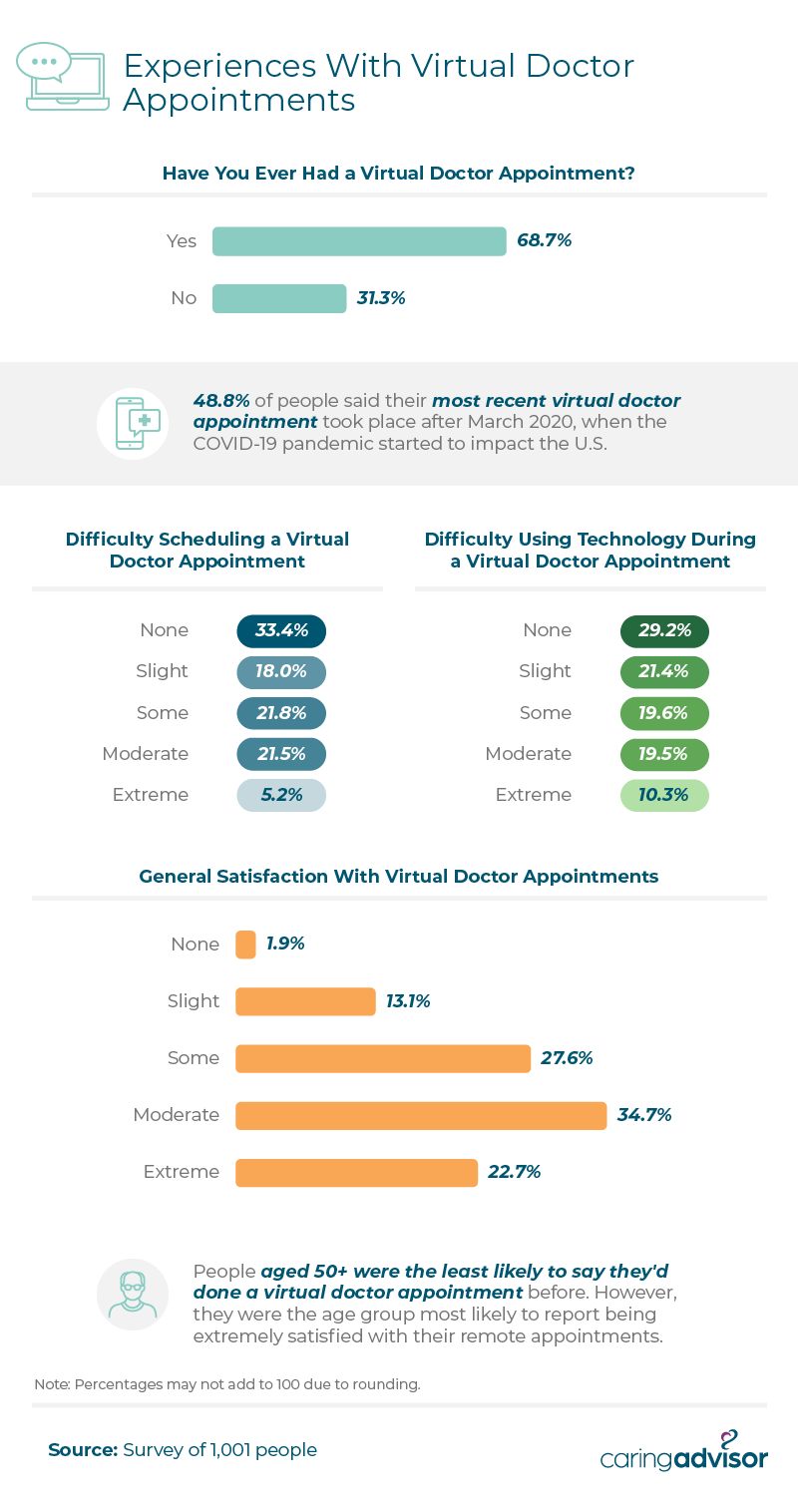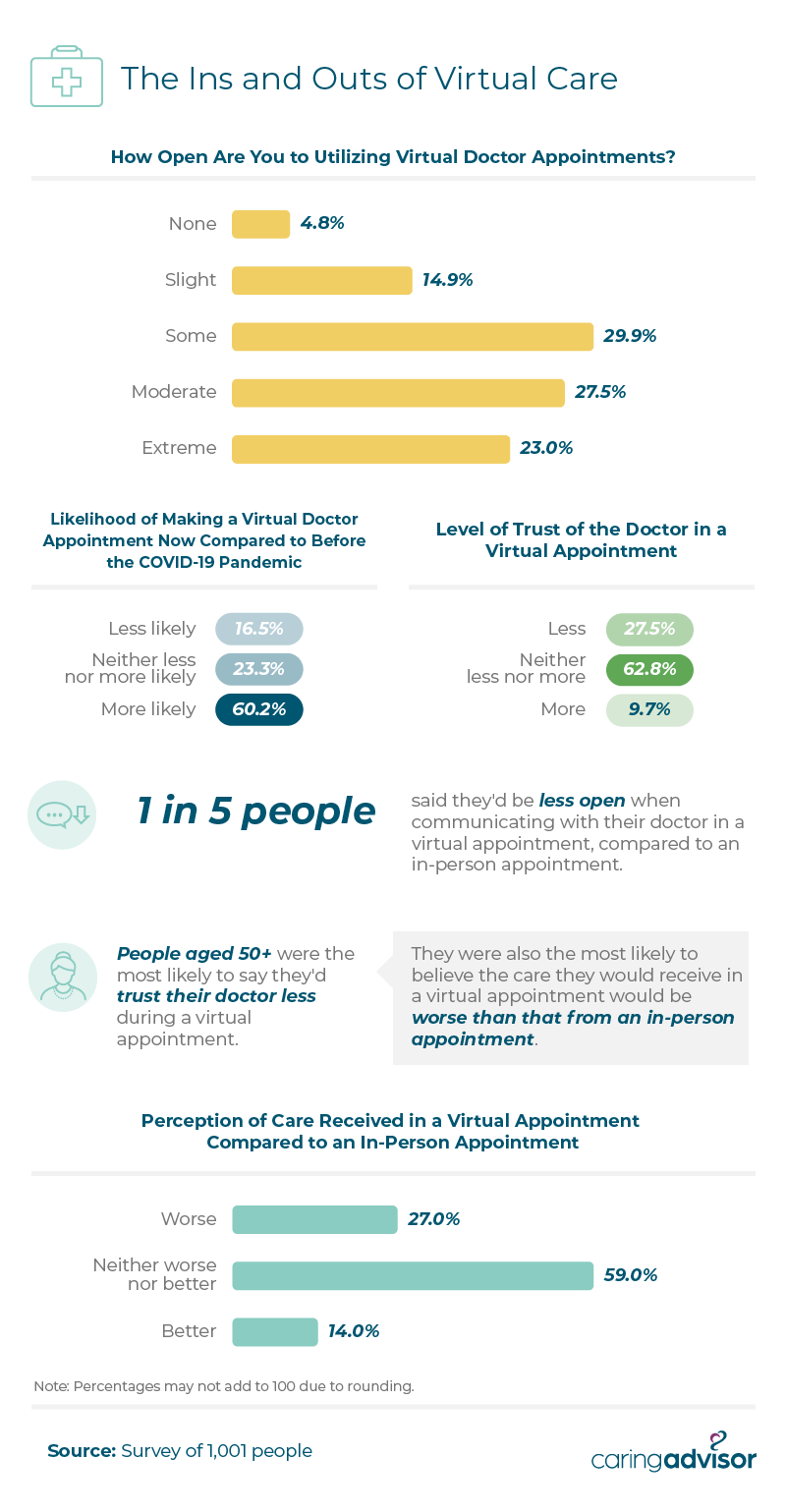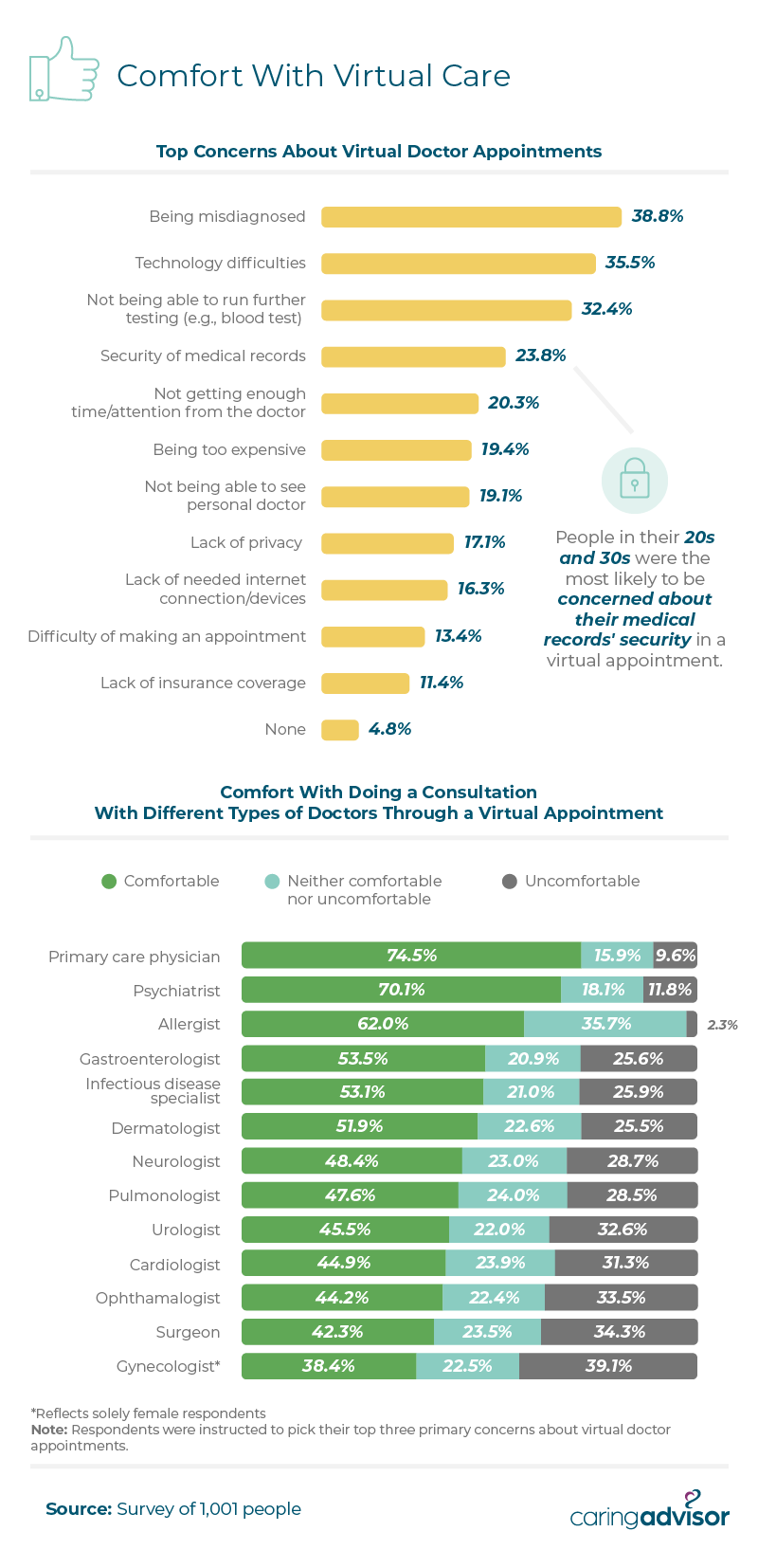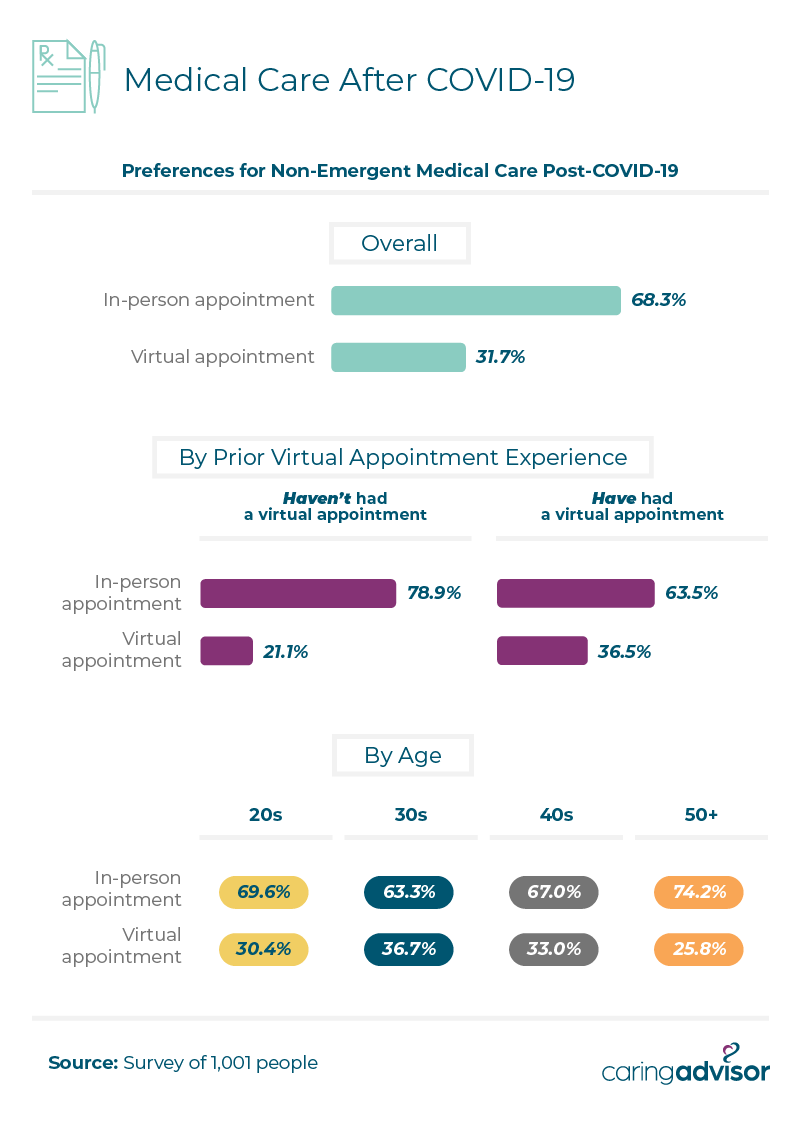
The doors of virtual doctors’ offices have been blown wide open. Instead of spiraling down the rabbit hole of Googling symptoms, people now have more opportunities to get advice from doctors and medical professionals through telemedicine. Telemedicine enables patients to receive diagnoses, get prescriptions, or even “go” to therapy, all from their electronic devices.
We spoke to more than 1,000 people about their perceptions of virtual doctor appointments. They shared some of their top concerns, while those who had actually tried it shared their personal experiences. Certain demographics were more keen for things to move virtual than others. Keep reading to see if your own concerns are matched or to find out if virtual medicine may have something to offer you.
Forecasting 2020 Medicine

If you’ve already had a virtual doctor appointment, what did you think? Was getting the appointment easy or difficult, and how satisfied were you by the end of it? Respondents who had attended at least one digital doctor appointment answered some of these questions for us.
Most people had tried telemedicine at some point in their life: 68.7% said they’d had a virtual doctor appointment before. Of this roughly 69%, nearly half said their most recent virtual experience occurred in March 2020 or after.
Although very few people were completely disappointed (fewer than 2% of respondents), most people encountered difficulty both in the scheduling of the appointment (66.6%) as well as the technology usage during the appointment (70.8%). Many doctors and patients are just getting used to meeting each other online and can experience the same frustrations as people using tools like Zoom at work. These technological difficulties may be why those aged 50 and up, who likely need safe doctor appointments the most, were the least likely to say they’d given virtual appointments a try. This is in spite of the fact that people 50-plus years old were also the most likely to rate their virtual experiences positively when they did do a digital appointment. In other words, this older demographic is missing out on the potential telemedicine has for them.
Considering Digital Care

If you’ve already had a virtual doctor appointment, what did you think? Was getting the appointment easy or difficult, and how satisfied were you by the end of it? Respondents who had attended at least one digital doctor appointment answered some of these questions for us.
Most people had tried telemedicine at some point in their life: 68.7% said they’d had a virtual doctor appointment before. Of this roughly 69%, nearly half said their most recent virtual experience occurred in March 2020 or after.
Although very few people were completely disappointed (fewer than 2% of respondents), most people encountered difficulty both in the scheduling of the appointment (66.6%) as well as the technology usage during the appointment (70.8%). Many doctors and patients are just getting used to meeting each other online and can experience the same frustrations as people using tools like Zoom at work. These technological difficulties may be why those aged 50 and up, who likely need safe doctor appointments the most, were the least likely to say they’d given virtual appointments a try. This is in spite of the fact that people 50-plus years old were also the most likely to rate their virtual experiences positively when they did do a digital appointment. In other words, this older demographic is missing out on the potential telemedicine has for them.
Considering Digital Care

We wanted to know how respondents perceived general care when it was virtual, especially in relation to what they were used to. They considered how open they’d be to at least trying virtual appointments with their doctors and even discussed how much they would trust a doctor in a virtual setting compared to in person.
Considering the circumstances, very few people (4.8%) were totally opposed to a virtual appointment with a doctor. Most were at least slightly amenable to the option. Their likelihood of interest saw a particular peak since COVID-19, with 60% saying they were more likely to try it now than they were before the pandemic.
But people’s expectations weren’t always high, even if they felt a virtual appointment worth considering. One in 5 agreed that they would be less forthright with their doctor in an online setting. It’s not always easy to guarantee privacy, especially with other members of the household in quarantine, and honest and open communication is a cornerstone to smart medicine, so the inability to do this online for some is an issue. Elderly respondents were also most likely to feel that they would trust their doctor less in a virtual appointment. Overall, only 27.5% of people were less trustful of this practice, however. Perception of care received was rated the same whether in person or remote for 59% of people.
Digital Medicine Concerns

Although mistrust and discomfort with virtual doctors weren’t uncommon, there were other concerns at play about receiving medical care online.
Being misdiagnosed was respondents’ top concern about virtual appointments. Thirty-eight percent of respondents took issue with this, hypothetically or in reality. To put this in perspective, however, it’s estimated that 12 million adults in the U.S. receive misdiagnoses from doctors during “normal” years, so this concern isn’t unique to telemedicine.
Difficult tech, however, is particular to telemedicine and was again a major issue, topping the list of concerns as well. Younger patients were most likely to be concerned about the security of medical information during digital doctor appointments.
Gynecology faces the biggest barriers when it comes to patient comfortability going virtual. Only just over 38% of women said they’d be perfectly comfortable doing consultation with a gynecologist virtually, the lowest percentage among the types of doctors studied. Better suited for online care were things like primary care physicians and psychiatrists, whom 74.5% and 70.1% said they’d be comfortable “visiting” online, respectively. These doctors are also more in demand during a pandemic, as both physical and mental health have taken an incredibly hard hit across the U.S.
Moving Forward With Medicine

There’s certainly been a forced “evolution” of medicine since the pandemic, but the real question is what to anticipate down the road. Respondents shared their preferences for their post-pandemic medical care. Their answers reference nonemergency medical care only.
Most people (68.3%) still wanted in-person appointments, despite the influx of doctors offering online opportunities. Telemedicine received a big boost under the $8.3 billion emergency funding measure from congress. As Dr. Peter Antall told The New York Times, “Everybody realizes [telemedicine] is an all hands on deck moment. We need to scale up wherever we can.” Perhaps even the most skeptical will be more inclined to try as these new developments to telemedicine are made.
Patients who had actually given telemedicine a shot were 15 percentage points more likely than people who hadn’t to prefer telemedicine in the future as well, even without a pandemic. There are major upsides to consider for all demographics: lowered transportation costs, flexibility in scheduling, and, of course, less of a chance to contract a new illness. That said, in-person appointments were still the main preference for most people moving forward.
Knowing Your Options
As you consider your own path forward with medicine, take note of respondents’ overall feelings: Most tended to prefer in-person appointments overall, but those who had tried telemedicine were more likely to prefer the practice. Above all, explore your options and know that the continually improving option of telemedicine is more available today than it was before.
Exploring your options when it comes to health can get overwhelming, so it’s important to have a resource that can help you. Caring Advisor helps you find a place that people will love to live as they age. You can sort all of your family’s options by location and facility needs and gain access to our resource center 24/7. Head to Caring Advisor today to get some help in choosing the best care option among those available to you and your loved ones.
Methodology
We surveyed 1,001 people about their experiences with and perceptions of virtual doctor appointments. Respondents were 56.5% men and 43.5% women. The average age of respondents was 38.8 with a standard deviation of 12.5.
The average number of appointments people have in a typical year was calculated to exclude outliers. This was done by finding the initial average and standard deviation and multiplying the latter by three. This product was then added to the initial average. Any data point above that sum was then excluded and the final average calculated.
When reporting their likelihood of making a virtual doctor appointment now compared to before the COVID-19 pandemic, respondents were given the following scale of options:
- Much less likely
- Less likely
- Neither less nor more likely
- More likely
- Much more likely
In our final visualization of the data, we combined these into the following groups: less likely, neither less nor more likely, and more likely.
Respondents were asked about how a virtual appointment would impact their trust of the doctor. They were given the following options:
- Much less
- Less
- Just as much
- More
- Much more
In our final visualization of the data, we combined those options into the following groups: less, neither less nor more, and more.
Respondents were also asked about their comfort with seeing different types of doctors in a virtual appointment for a consultation, which we defined for respondents as “a meeting where a health care provider reviews a patient’s medical records, examines the patient, and makes recommendations about treatment and care.” They rated each type of doctor on the following scale:
- Extremely uncomfortable
- Uncomfortable
- Neither uncomfortable nor comfortable
- Comfortable
- Extremely comfortable
In our final data visualization, we combined these into comfortable, neither comfortable nor uncomfortable, and uncomfortable groups. As noted in the graphic, gynecologist percentages were based solely on the responses of female respondents.
Limitations
The data we are presenting rely on self-report. There are many issues with self-reported data. These issues include, but are not limited to, the following: selective memory, telescoping, attribution, and exaggeration.
Fair Use Statement
Virtual medical appointments offer an interesting opportunity to the health care industry, but it’s natural for people to be unsure of new services. If someone you know would benefit from the information in this project, you may share for any noncommercial reuse. Please link back here so the entire project can be explored and the methodology can be reviewed. This also gives credit to our hardworking contributors, without whom this work wouldn’t be possible.
